
India-Specific Outcomes: Cashless Pathways, Follow-Up Adherence, and Real-World KPIs for Clinicians
Prosthetic care in India is changing very quickly.More people are receiving quality devices, more hospitals
Buy Products, Consumables and Accessories from Robo Bionics Dismiss
Skip to content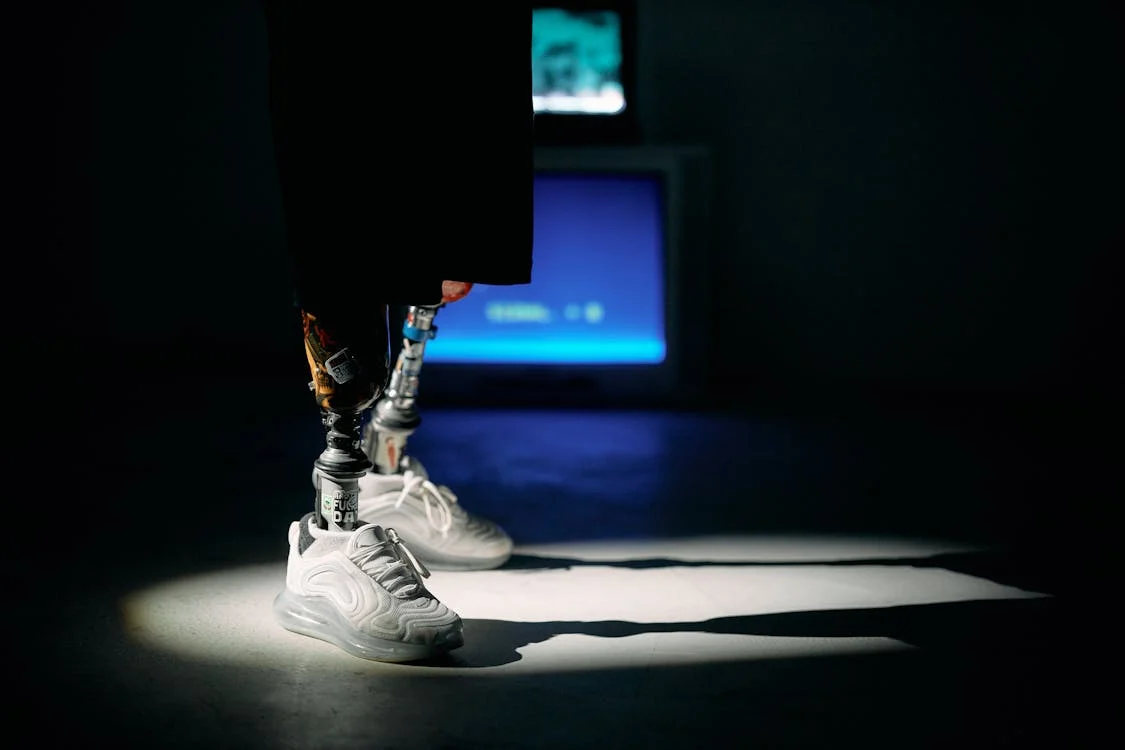
Living with limb loss can be challenging, but modern prosthetic technology offers life-changing solutions. Whether you have lost a part of your foot or your entire leg up to the pelvis, the right prosthetic can restore mobility, independence, and confidence.
Partial foot and hemipelvectomy prosthetics are designed for different levels of limb loss, but both require careful selection, customization, and rehabilitation. Choosing the right prosthesis is not just about getting a replacement—it’s about finding a solution that fits your lifestyle, provides comfort, and helps you move naturally.
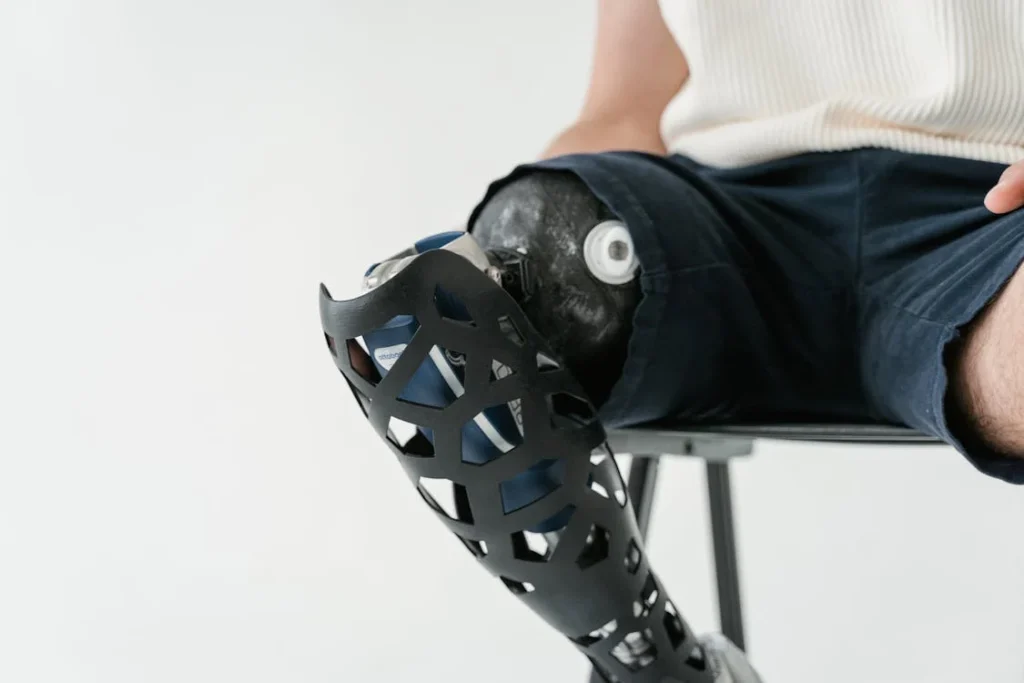
Prosthetics for partial foot and hemipelvectomy amputations serve different purposes based on the level of limb loss.
While both help restore function and mobility, they are designed differently to address the unique challenges of each condition.
A partial foot prosthesis is used when only a part of the foot is missing. This can include toes, the front part of the foot, or even up to the midfoot.
The main goal of this type of prosthetic is to restore balance, improve walking ability, and prevent complications like uneven weight distribution, which can cause pain in other parts of the body.
These prosthetics are designed to fit comfortably inside a shoe, providing support and helping the user walk more naturally.
Depending on the level of amputation, a partial foot prosthesis can be a simple insert or a more structured device that extends up to the ankle for extra support.
Many people believe that losing just a part of the foot won’t affect mobility much, but even small changes in foot structure can lead to major challenges.
Without proper support, walking can become painful, and over time, the body may compensate in ways that cause discomfort in the knees, hips, or back.
One of the biggest challenges with partial foot prosthetics is achieving a natural walking motion.
The foot plays a crucial role in pushing off the ground, maintaining balance, and absorbing shock with every step. When a part of the foot is missing, these functions are affected.
Another challenge is keeping the prosthetic secure. Since the remaining foot still has sensation and movement, a poorly fitted prosthesis can slip or cause pressure sores.
This is why custom fitting is crucial. A well-made prosthetic will not only restore function but also protect the remaining part of the foot from injuries.
A hemipelvectomy prosthesis is designed for individuals who have lost their entire leg, including part of the pelvis.
This is one of the most complex prosthetic solutions because it must replace not only the leg but also provide stability where the hip joint used to be.
Unlike a partial foot prosthesis, which fits inside a shoe, a hemipelvectomy prosthesis is a complete external system that includes a custom-made socket, a mechanical or computerized knee joint, and a prosthetic foot.
It must provide enough support to allow the user to sit, stand, and walk comfortably.
A hemipelvectomy amputation is rare, often resulting from severe trauma, tumors, or infections.
The loss of an entire leg and part of the pelvis significantly changes how the body moves, making rehabilitation and training an essential part of adapting to a prosthetic.
Because there is no natural hip joint to support movement, walking with a hemipelvectomy prosthesis requires learning new ways to control balance and motion.
The prosthetic must be carefully designed to distribute weight evenly and provide stability during movement.
Since these prosthetics involve multiple components, getting the right fit and alignment is critical.
A poorly fitted prosthetic can cause discomfort, skin irritation, and even long-term issues like joint pain or posture problems.
Another challenge is energy consumption. Walking with a hemipelvectomy prosthesis takes more effort than walking with a natural leg.
However, advancements in prosthetic technology have led to lighter materials and improved designs that make movement more efficient.

Finding the right prosthetic is not just about replacing what is lost—it’s about restoring function, comfort, and confidence.
Whether you need a partial foot prosthesis or a hemipelvectomy prosthesis, the selection process should be based on your lifestyle, daily activities, and long-term goals.
A partial foot prosthesis must provide both comfort and stability while allowing you to walk as naturally as possible. Choosing the right one involves several key factors:
Level of Amputation
The type of prosthetic will depend on how much of the foot is missing. A toe amputation may only require a small insert, while a midfoot amputation might need a device that extends up the ankle for better support.
Footwear Compatibility
Most partial foot prostheses are designed to fit inside a shoe, but not all shoes work well with them.
It’s important to choose footwear that provides enough space, support, and grip to keep the prosthetic secure. Some individuals may need custom-made shoes to ensure a proper fit.
Material and Comfort
A prosthetic that is too hard can cause discomfort, while one that is too soft may not provide enough support. Modern prosthetics use lightweight materials like carbon fiber or silicone to offer a balance of flexibility and durability.
The inner surface should be soft enough to prevent irritation, while the outer structure should be firm enough to provide stability.
Skin Protection
Since the remaining part of the foot still has sensation, pressure points and friction can cause sores or blisters. A well-fitted prosthetic will distribute weight evenly and reduce the risk of skin problems.
It’s also important to check your skin regularly and ensure the prosthetic is not causing any discomfort.
A hemipelvectomy prosthesis is much more complex than a partial foot prosthetic, as it replaces an entire leg and part of the pelvis. The right choice will depend on several key aspects:
Prosthetic Design and Components
A hemipelvectomy prosthetic typically includes a custom-made socket, a mechanical or computerized knee joint, and a prosthetic foot.
Some advanced models include microprocessor-controlled knees that adjust to different walking speeds and terrains, making movement more natural and efficient.
Weight and Energy Efficiency
Since walking with a hemipelvectomy prosthetic requires more effort than walking with a natural leg, the weight of the prosthesis is a crucial factor.
Lighter materials like titanium and carbon fiber help reduce strain and make movement easier.
Suspension System
A hemipelvectomy prosthesis must stay securely in place without causing discomfort. Different suspension systems, including vacuum-assisted suction and straps, are available to ensure a snug fit.
A secure fit prevents movement inside the socket, which can cause skin irritation and discomfort.
Rehabilitation and Adaptation
Getting used to a hemipelvectomy prosthetic takes time and practice. Physical therapy is essential to help users learn how to balance, walk, and move efficiently.
Gamified home-based rehabilitation programs, like those offered by Robobionics, can make this process smoother and more engaging, helping users adapt more quickly.
No two people are the same, which is why prosthetics must be customized for each individual.
A prosthetic that fits well will not only be more comfortable but also improve mobility and reduce strain on the rest of the body.
Robobionics provides personalized prosthetic solutions that take into account the user’s unique needs.
From precise fittings to advanced prosthetic designs, we ensure that every prosthetic supports natural movement and enhances the quality of life.
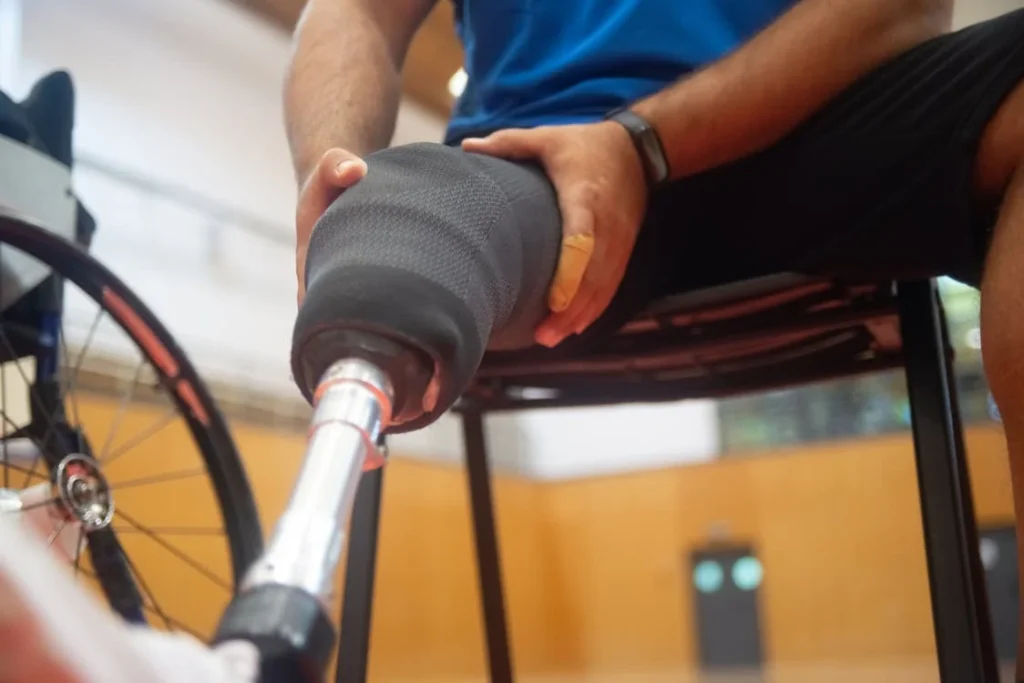
Getting a prosthetic is not just about receiving a device; it is a journey that involves careful fitting, adjustments, and rehabilitation.
Both partial foot and hemipelvectomy prosthetics require a structured approach to ensure they function properly and comfortably.
A well-fitted prosthetic makes all the difference in mobility and comfort. If a prosthesis is too loose, it can slip, cause instability, and lead to sores or blisters.
If it is too tight, it can restrict movement and cause discomfort.
The fitting process begins with an assessment by a prosthetist, who will take detailed measurements and evaluate factors like residual limb shape, skin sensitivity, and muscle strength.
For partial foot prosthetics, this ensures the device aligns well with the remaining foot structure. For hemipelvectomy prosthetics, it determines how weight will be distributed across the socket for balance and stability.
Modern prosthetics use 3D scanning and computer-aided design to create highly precise fits.
Advanced materials help create prosthetics that feel natural while maintaining durability.
Once the prosthetic is designed, a trial period follows. During this phase, users wear the device and provide feedback on comfort, fit, and ease of movement. Adjustments may be needed to refine the fit and ensure proper weight distribution.
For partial foot prosthetics, this might involve modifying the insole or adjusting the shape of the prosthetic for better alignment.
For hemipelvectomy prosthetics, adjustments may include fine-tuning the knee joint, socket fit, or suspension system.
Whether adapting to a partial foot or hemipelvectomy prosthesis, walking feels different at first. The body must adjust to a new way of moving, redistributing weight, and maintaining balance.
For partial foot prosthetics, users often need to focus on improving balance and learning how to use their remaining foot effectively. Some may need to adjust their walking pattern to ensure even weight distribution and avoid straining the knee or hip.
For hemipelvectomy prosthetics, the process is more complex. Since the hip joint is missing, walking requires learning how to use the prosthesis to generate motion.
Many users begin with parallel bars for support, gradually transitioning to walking with a cane or independently. Physical therapy plays a crucial role in strengthening muscles and improving coordination.
Rehabilitation is essential for long-term success with any prosthetic. It helps users regain strength, flexibility, and confidence in movement. A structured rehabilitation program typically includes:
Robobionics offers gamified home-based rehabilitation programs that make this process engaging and effective. These programs use interactive exercises to encourage users to practice movements in a fun and motivating way.
Even after initial rehabilitation, ongoing care is important. Prosthetics may need periodic adjustments due to changes in body weight, residual limb shape, or activity level.
Regular check-ups with a prosthetist help ensure the device remains comfortable and functional.
Proper skin care is also vital, especially for individuals using hemipelvectomy prosthetics, where the socket covers a large surface area. Checking for irritation, maintaining hygiene, and using protective liners can help prevent discomfort.
Living with a prosthetic is a journey of adaptation, but with the right support, users can regain independence and lead active lives. Robobionics is committed to providing advanced prosthetic solutions and ongoing support to ensure the best possible outcomes for every user.

Adapting to life with a partial foot or hemipelvectomy prosthesis comes with unique challenges.
From navigating different surfaces to managing daily activities, every user faces a learning curve. However, with the right approach, these challenges can be overcome, allowing for a more comfortable and active lifestyle.
One of the first adjustments after getting a prosthetic is learning to walk on various surfaces. Flat indoor floors are the easiest to navigate, but outdoor environments can be unpredictable.
For partial foot prosthetic users, walking on uneven ground like grass or gravel requires extra attention to balance. Since the foot’s natural push-off motion is affected, wearing proper footwear with a strong grip can help.
Some prosthetics come with energy-returning features that assist with propulsion, making walking smoother.
For hemipelvectomy prosthetic users, terrains like stairs, slopes, or soft ground require different movement techniques. Many users find that taking smaller steps and focusing on weight distribution helps prevent falls.
Practicing on different surfaces with the help of a physical therapist can build confidence and improve mobility.
Wearing a prosthetic for long hours can sometimes lead to discomfort, especially if the fit is not perfect. Heat, friction, and pressure points can cause irritation, so it is important to monitor the skin regularly.
For partial foot prosthetics, ensuring proper sock thickness and choosing breathable materials can help prevent sweating and blisters. Some users may benefit from wearing gel liners that provide extra cushioning.
For hemipelvectomy prosthetic users, socket discomfort can occur after extended use. Adjusting the prosthetic periodically, using specialized padding, and taking short breaks throughout the day can help relieve pressure.
Regular check-ins with a prosthetist can ensure that the socket fit remains comfortable.
Many people worry that using a prosthetic will limit their ability to stay active. However, with the right adjustments, it is possible to return to hobbies, exercise, and even sports.
For those with partial foot prosthetics, activities like walking, cycling, and swimming are usually manageable with minor adaptations. Some prosthetic designs offer extra flexibility, making it easier to engage in physical activities without discomfort.
For hemipelvectomy prosthetic users, returning to an active lifestyle takes more time, but it is achievable. Many users participate in activities like adaptive yoga, weight training, and even running with specially designed prosthetics.
The key is to start slowly, build strength, and work with a professional to ensure safe movement.
Beyond the physical challenges, adjusting to a prosthetic also involves emotional and social changes. It is natural to feel self-conscious or frustrated at times, but connecting with others who have gone through similar experiences can be incredibly helpful.
Joining support groups, talking to other prosthetic users, and sharing experiences can provide encouragement. At Robobionics, we believe in empowering our users by offering not just prosthetic solutions, but also a community of support.
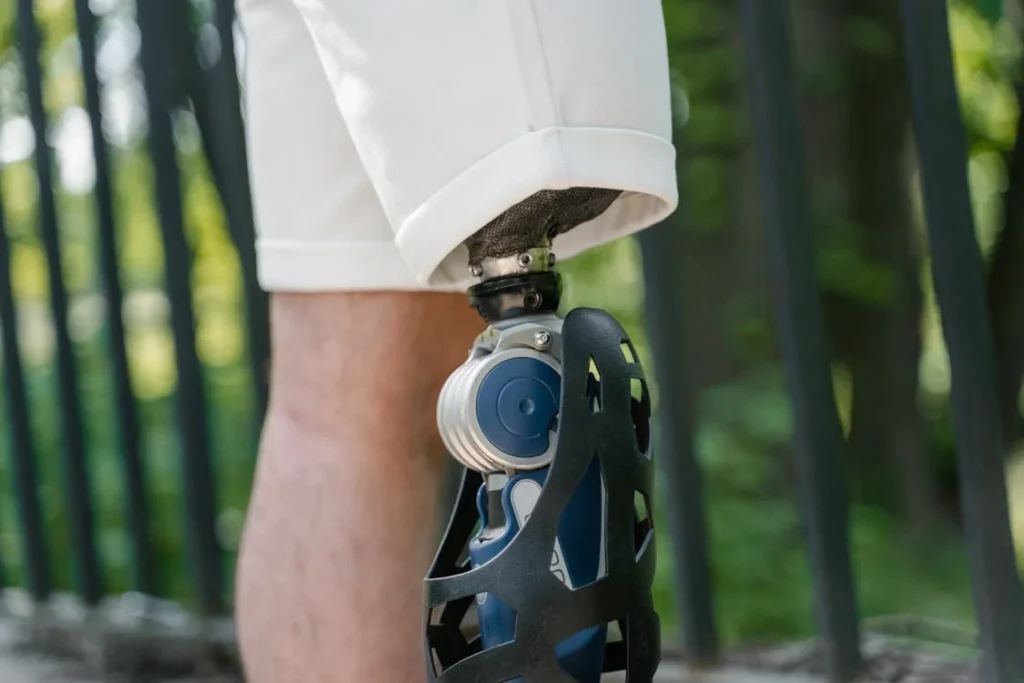
Prosthetic technology has come a long way, making life easier for people with limb loss. Innovations in materials, design, and functionality have improved both partial foot and hemipelvectomy prosthetics, offering users greater comfort, mobility, and independence.
Modern prosthetics use advanced materials like carbon fiber, titanium, and medical-grade silicone. These materials offer a perfect balance between strength and weight, allowing for prosthetics that are both durable and comfortable.
For partial foot prosthetics, lightweight materials help users walk with minimal strain. Silicone-based prosthetics mimic the look and feel of a natural foot while providing flexibility for smoother movement.
Carbon fiber options offer energy return, making walking more efficient.
For hemipelvectomy prosthetics, the use of lightweight materials reduces the overall energy required for walking. Older designs were often bulky and heavy, making movement difficult.
Today’s models are significantly lighter, enabling better mobility without added fatigue.
Every prosthetic user has different needs, which is why customization is crucial. Advances in 3D scanning and printing allow prosthetists to create highly personalized prosthetics that match the exact shape and size of the residual limb.
For partial foot prosthetic users, this means better alignment, improved comfort, and a more natural walking motion. Some designs even include textured surfaces that replicate the feel of a natural foot inside a shoe.
For hemipelvectomy prosthetic users, custom sockets play a crucial role in comfort and functionality. A well-fitted socket ensures even weight distribution and reduces pressure points.
Suspension systems have also improved, with vacuum-assisted technology providing a secure yet comfortable fit.
One of the biggest breakthroughs in prosthetic technology is the introduction of microprocessor-controlled joints. These are especially beneficial for hemipelvectomy prosthetics, where movement control is more complex.
Unlike traditional mechanical joints, microprocessor-controlled knees and hips adjust to walking speed and terrain in real-time. This makes movement more fluid and natural, reducing the risk of falls and improving overall mobility.
For users who engage in active lifestyles, these smart prosthetics can detect shifts in balance and adjust accordingly, offering a smoother walking experience. While these advanced prosthetics are more expensive, they provide unmatched functionality and ease of use.
Rehabilitation is a key part of adapting to a prosthetic, and modern technology has made this process more engaging. Gamified rehabilitation programs, like those offered by Robobionics, use interactive exercises to help users improve their movement in a fun and effective way.
Smart prosthetics, which connect to mobile apps, allow users to track their walking patterns and receive feedback on posture and movement. Some even offer real-time adjustments through AI-driven systems, ensuring optimal performance throughout the day.
As technology continues to advance, prosthetic solutions will become even more intuitive and user-friendly. Researchers are developing prosthetics with sensory feedback, allowing users to “feel” pressure and texture through artificial nerves.
This breakthrough could revolutionize how prosthetic users interact with their environment.
At Robobionics, we are committed to bringing these advancements to our users, ensuring that everyone has access to the best prosthetic solutions available. Whether it’s through lightweight materials, custom designs, or smart technology, our goal is to improve mobility and enhance quality of life.
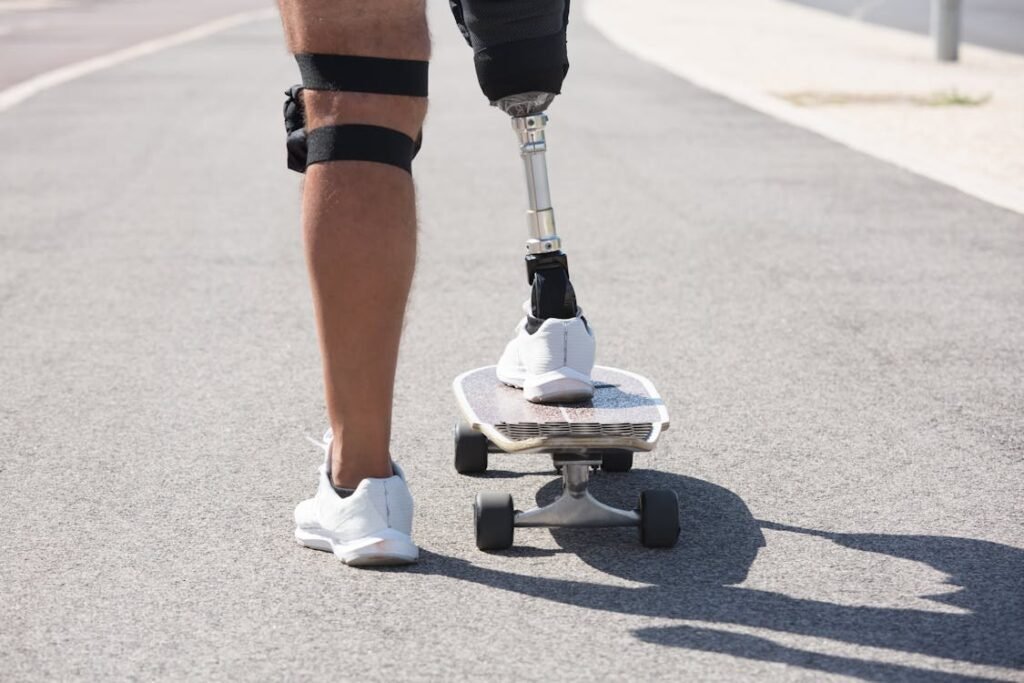
Getting a prosthetic is just the beginning. To ensure that a partial foot or hemipelvectomy prosthesis lasts long and functions properly, regular care and maintenance are essential.
Proper upkeep not only extends the life of the prosthetic but also prevents discomfort and potential health issues.
Keeping a prosthetic clean is crucial to avoid skin irritation and infections. Since prosthetics are worn for long hours, sweat and friction can create a breeding ground for bacteria.
For partial foot prosthetic users, cleaning the prosthetic daily with mild soap and warm water helps maintain hygiene. If the prosthetic includes a liner or insert, these should also be cleaned and dried properly before wearing.
Wearing moisture-wicking socks can help reduce sweating and keep the foot dry.
For hemipelvectomy prosthetic users, the socket and suspension system should be wiped down regularly. Any part that comes into direct contact with the skin should be cleaned with antibacterial wipes or mild soap to prevent irritation.
It’s also important to check for any signs of redness or pressure sores, as prolonged friction can lead to skin breakdown.
Over time, prosthetics undergo natural wear and tear. Regularly inspecting the device can help identify small issues before they turn into major problems.
For partial foot prosthetics, users should check for cracks, loose padding, or changes in fit. A worn-out prosthetic can affect balance and cause strain on other parts of the body. If any part of the prosthetic feels unstable, a prosthetist should be consulted for adjustments.
For hemipelvectomy prosthetics, paying attention to the knee joint, foot mechanism, and suspension system is important. If the prosthetic feels loose, unstable, or makes unusual noises, it may need servicing.
Some advanced prosthetics with microprocessor-controlled joints may also require occasional software updates to ensure optimal performance.
The body changes over time, and these changes can affect how a prosthetic fits. Weight fluctuations, muscle development, or changes in activity level may require adjustments to the prosthetic.
For partial foot prosthetic users, even small changes in foot shape can affect comfort. Regular check-ups help ensure that the prosthetic continues to fit well and provide the necessary support.
For hemipelvectomy prosthetic users, socket fit is critical. If the socket becomes too tight or too loose, it can lead to discomfort and difficulty walking. Some suspension systems allow for minor fit adjustments, but significant changes may require a new socket or modifications by a prosthetist.
Even with regular maintenance, there will be times when professional adjustments are needed. Users should schedule an appointment with their prosthetist if they experience:
At Robobionics, we provide ongoing support to ensure that prosthetic users receive timely maintenance and repairs.
Our goal is to make prosthetic care as seamless as possible, so users can focus on living their lives without unnecessary discomfort or inconvenience.
Living with a partial foot or hemipelvectomy prosthesis is a journey that requires the right prosthetic, proper rehabilitation, and ongoing care. With advancements in technology, prosthetic solutions today offer greater comfort, mobility, and independence than ever before. Whether it’s a lightweight partial foot prosthesis or a highly advanced hemipelvectomy prosthetic, the right fit can make all the difference in everyday life.
Adapting to a prosthetic takes time, but with structured rehabilitation and the right support system, users can regain confidence and return to an active lifestyle. Regular maintenance ensures long-term comfort, while innovations like gamified rehabilitation and smart prosthetics continue to improve the user experience.
At Robobionics, we are dedicated to providing high-quality prosthetic solutions tailored to each individual’s needs. From precise fittings to long-term support, we ensure that every user receives the best possible care. If you or a loved one is exploring prosthetic options, contact us today to learn how we can help restore mobility and independence.

Prosthetic care in India is changing very quickly.More people are receiving quality devices, more hospitals

Accepting a prosthesis is not only a physical process.It is also an emotional journey filled

Outcome dashboards are becoming one of the most important tools in modern prosthetic clinics.They help

In prosthetic rehabilitation, numbers only matter when they mean something to real people.A test score
Last updated: November 10, 2022
Thank you for shopping at Robo Bionics.
If, for any reason, You are not completely satisfied with a purchase We invite You to review our policy on refunds and returns.
The following terms are applicable for any products that You purchased with Us.
The words of which the initial letter is capitalized have meanings defined under the following conditions. The following definitions shall have the same meaning regardless of whether they appear in singular or in plural.
For the purposes of this Return and Refund Policy:
Company (referred to as either “the Company”, “Robo Bionics”, “We”, “Us” or “Our” in this Agreement) refers to Bionic Hope Private Limited, Pearl Haven, 1st Floor Kumbharwada, Manickpur Near St. Michael’s Church Vasai Road West, Palghar Maharashtra 401202.
Goods refer to the items offered for sale on the Website.
Orders mean a request by You to purchase Goods from Us.
Service refers to the Services Provided like Online Demo and Live Demo.
Website refers to Robo Bionics, accessible from https://robobionics.in
You means the individual accessing or using the Service, or the company, or other legal entity on behalf of which such individual is accessing or using the Service, as applicable.
You are entitled to cancel Your Service Bookings within 7 days without giving any reason for doing so, before completion of Delivery.
The deadline for cancelling a Service Booking is 7 days from the date on which You received the Confirmation of Service.
In order to exercise Your right of cancellation, You must inform Us of your decision by means of a clear statement. You can inform us of your decision by:
We will reimburse You no later than 7 days from the day on which We receive your request for cancellation, if above criteria is met. We will use the same means of payment as You used for the Service Booking, and You will not incur any fees for such reimbursement.
Please note in case you miss a Service Booking or Re-schedule the same we shall only entertain the request once.
In order for the Goods to be eligible for a return, please make sure that:
The following Goods cannot be returned:
We reserve the right to refuse returns of any merchandise that does not meet the above return conditions in our sole discretion.
Only regular priced Goods may be refunded by 50%. Unfortunately, Goods on sale cannot be refunded. This exclusion may not apply to You if it is not permitted by applicable law.
You are responsible for the cost and risk of returning the Goods to Us. You should send the Goods at the following:
We cannot be held responsible for Goods damaged or lost in return shipment. Therefore, We recommend an insured and trackable courier service. We are unable to issue a refund without actual receipt of the Goods or proof of received return delivery.
If you have any questions about our Returns and Refunds Policy, please contact us:
Last Updated on: 1st Jan 2021
These Terms and Conditions (“Terms”) govern Your access to and use of the website, platforms, applications, products and services (ively, the “Services”) offered by Robo Bionics® (a registered trademark of Bionic Hope Private Limited, also used as a trade name), a company incorporated under the Companies Act, 2013, having its Corporate office at Pearl Heaven Bungalow, 1st Floor, Manickpur, Kumbharwada, Vasai Road (West), Palghar – 401202, Maharashtra, India (“Company”, “We”, “Us” or “Our”). By accessing or using the Services, You (each a “User”) agree to be bound by these Terms and all applicable laws and regulations. If You do not agree with any part of these Terms, You must immediately discontinue use of the Services.
1.1 “Individual Consumer” means a natural person aged eighteen (18) years or above who registers to use Our products or Services following evaluation and prescription by a Rehabilitation Council of India (“RCI”)–registered Prosthetist.
1.2 “Entity Consumer” means a corporate organisation, nonprofit entity, CSR sponsor or other registered organisation that sponsors one or more Individual Consumers to use Our products or Services.
1.3 “Clinic” means an RCI-registered Prosthetics and Orthotics centre or Prosthetist that purchases products and Services from Us for fitment to Individual Consumers.
1.4 “Platform” means RehabConnect™, Our online marketplace by which Individual or Entity Consumers connect with Clinics in their chosen locations.
1.5 “Products” means Grippy® Bionic Hand, Grippy® Mech, BrawnBand™, WeightBand™, consumables, accessories and related hardware.
1.6 “Apps” means Our clinician-facing and end-user software applications supporting Product use and data collection.
1.7 “Impact Dashboard™” means the analytics interface provided to CSR, NGO, corporate and hospital sponsors.
1.8 “Services” includes all Products, Apps, the Platform and the Impact Dashboard.
2.1 Individual Consumers must be at least eighteen (18) years old and undergo evaluation and prescription by an RCI-registered Prosthetist prior to purchase or use of any Products or Services.
2.2 Entity Consumers must be duly registered under the laws of India and may sponsor one or more Individual Consumers.
2.3 Clinics must maintain valid RCI registration and comply with all applicable clinical and professional standards.
3.1 Robo Bionics acts solely as an intermediary connecting Users with Clinics via the Platform. We do not endorse or guarantee the quality, legality or outcomes of services rendered by any Clinic. Each Clinic is solely responsible for its professional services and compliance with applicable laws and regulations.
4.1 All content, trademarks, logos, designs and software on Our website, Apps and Platform are the exclusive property of Bionic Hope Private Limited or its licensors.
4.2 Subject to these Terms, We grant You a limited, non-exclusive, non-transferable, revocable license to use the Services for personal, non-commercial purposes.
4.3 You may not reproduce, modify, distribute, decompile, reverse engineer or create derivative works of any portion of the Services without Our prior written consent.
5.1 Limited Warranty. We warrant that Products will be free from workmanship defects under normal use as follows:
(a) Grippy™ Bionic Hand, BrawnBand® and WeightBand®: one (1) year from date of purchase, covering manufacturing defects only.
(b) Chargers and batteries: six (6) months from date of purchase.
(c) Grippy Mech™: three (3) months from date of purchase.
(d) Consumables (e.g., gloves, carry bags): no warranty.
5.2 Custom Sockets. Sockets fabricated by Clinics are covered only by the Clinic’s optional warranty and subject to physiological changes (e.g., stump volume, muscle sensitivity).
5.3 Exclusions. Warranty does not apply to damage caused by misuse, user negligence, unauthorised repairs, Acts of God, or failure to follow the Instruction Manual.
5.4 Claims. To claim warranty, You must register the Product online, provide proof of purchase, and follow the procedures set out in the Warranty Card.
5.5 Disclaimer. To the maximum extent permitted by law, all other warranties, express or implied, including merchantability and fitness for a particular purpose, are disclaimed.
6.1 We collect personal contact details, physiological evaluation data, body measurements, sensor calibration values, device usage statistics and warranty information (“User Data”).
6.2 User Data is stored on secure servers of our third-party service providers and transmitted via encrypted APIs.
6.3 By using the Services, You consent to collection, storage, processing and transfer of User Data within Our internal ecosystem and to third-party service providers for analytics, R&D and support.
6.4 We implement reasonable security measures and comply with the Information Technology Act, 2000, and Information Technology (Reasonable Security Practices and Procedures and Sensitive Personal Data or Information) Rules, 2011.
6.5 A separate Privacy Policy sets out detailed information on data processing, user rights, grievance redressal and cross-border transfers, which forms part of these Terms.
7.1 Pursuant to the Information Technology Rules, 2021, We have given the Charge of Grievance Officer to our QC Head:
- Address: Grievance Officer
- Email: support@robobionics.in
- Phone: +91-8668372127
7.2 All support tickets and grievances must be submitted exclusively via the Robo Bionics Customer Support portal at https://robobionics.freshdesk.com/.
7.3 We will acknowledge receipt of your ticket within twenty-four (24) working hours and endeavour to resolve or provide a substantive response within seventy-two (72) working hours, excluding weekends and public holidays.
8.1 Pricing. Product and Service pricing is as per quotations or purchase orders agreed in writing.
8.2 Payment. We offer (a) 100% advance payment with possible incentives or (b) stage-wise payment plans without incentives.
8.3 Refunds. No refunds, except pro-rata adjustment where an Individual Consumer is medically unfit to proceed or elects to withdraw mid-stage, in which case unused stage fees apply.
9.1 Users must follow instructions provided by RCI-registered professionals and the User Manual.
9.2 Users and Entity Consumers shall indemnify and hold Us harmless from all liabilities, claims, damages and expenses arising from misuse of the Products, failure to follow professional guidance, or violation of these Terms.
10.1 To the extent permitted by law, Our total liability for any claim arising out of or in connection with these Terms or the Services shall not exceed the aggregate amount paid by You to Us in the twelve (12) months preceding the claim.
10.2 We shall not be liable for any indirect, incidental, consequential or punitive damages, including loss of profit, data or goodwill.
11.1 Our Products are classified as “Rehabilitation Aids,” not medical devices for diagnostic purposes.
11.2 Manufactured under ISO 13485:2016 quality management and tested for electrical safety under IEC 60601-1 and IEC 60601-1-2.
11.3 Products shall only be used under prescription and supervision of RCI-registered Prosthetists, Physiotherapists or Occupational Therapists.
We do not host third-party content or hardware. Any third-party services integrated with Our Apps are subject to their own terms and privacy policies.
13.1 All intellectual property rights in the Services and User Data remain with Us or our licensors.
13.2 Users grant Us a perpetual, irrevocable, royalty-free licence to use anonymised usage data for analytics, product improvement and marketing.
14.1 We may amend these Terms at any time. Material changes shall be notified to registered Users at least thirty (30) days prior to the effective date, via email and website notice.
14.2 Continued use of the Services after the effective date constitutes acceptance of the revised Terms.
Neither party shall be liable for delay or failure to perform any obligation under these Terms due to causes beyond its reasonable control, including Acts of God, pandemics, strikes, war, terrorism or government regulations.
16.1 All disputes shall be referred to and finally resolved by arbitration under the Arbitration and Conciliation Act, 1996.
16.2 A sole arbitrator shall be appointed by Bionic Hope Private Limited or, failing agreement within thirty (30) days, by the Mumbai Centre for International Arbitration.
16.3 Seat of arbitration: Mumbai, India.
16.4 Governing law: Laws of India.
16.5 Courts at Mumbai have exclusive jurisdiction over any proceedings to enforce an arbitral award.
17.1 Severability. If any provision is held invalid or unenforceable, the remainder shall remain in full force.
17.2 Waiver. No waiver of any breach shall constitute a waiver of any subsequent breach of the same or any other provision.
17.3 Assignment. You may not assign your rights or obligations without Our prior written consent.
By accessing or using the Products and/or Services of Bionic Hope Private Limited, You acknowledge that You have read, understood and agree to be bound by these Terms and Conditions.